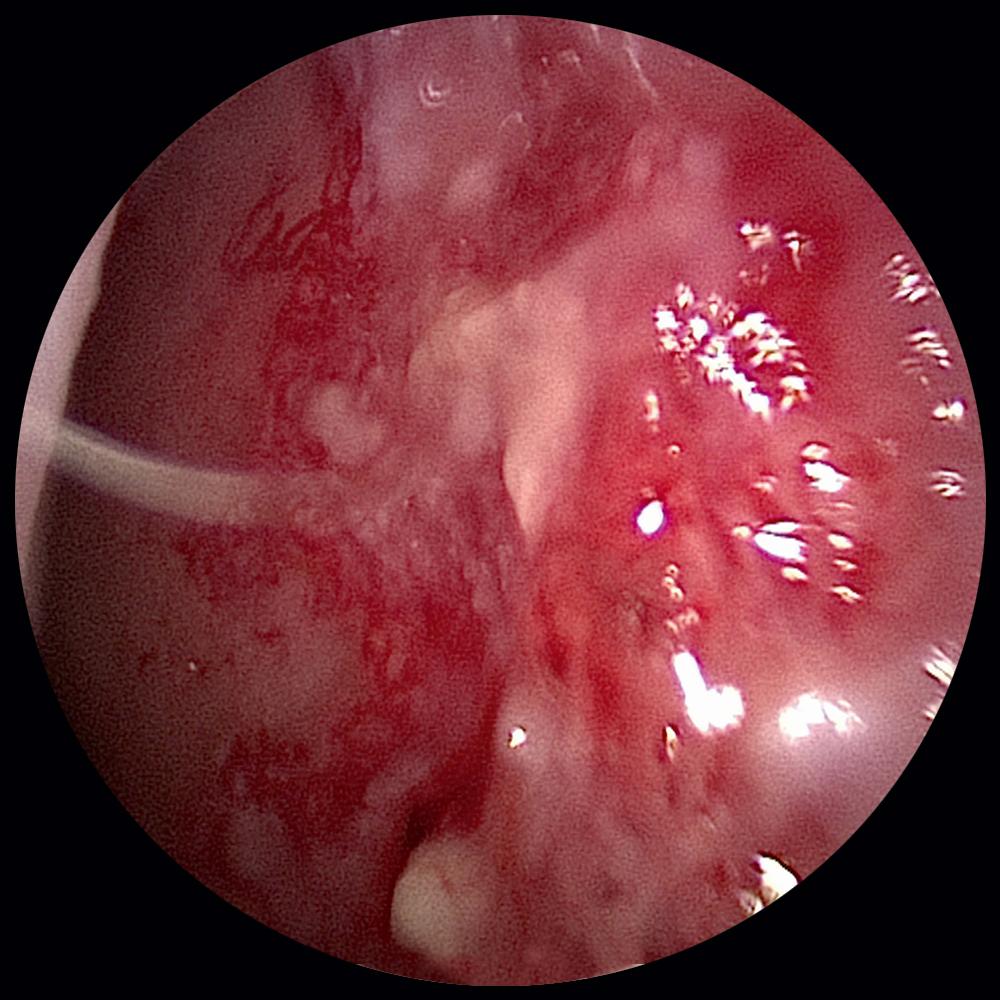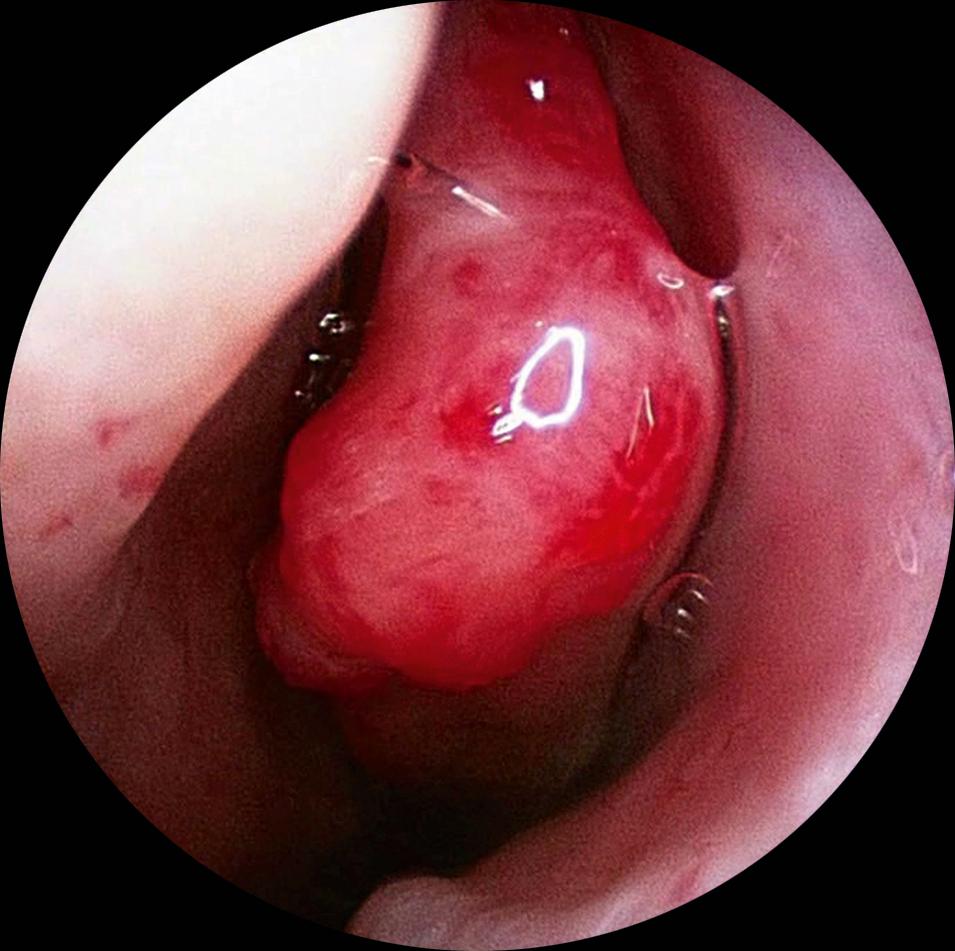Physical Address
304 North Cardinal St.
Dorchester Center, MA 02124
Hereditary hemorrhagic telangiectasia (HHT) is an autosomal dominant genetic disorder with incomplete penetrance that is characterized by arteriovenous malformations (AVMs) in various organs and mucocutaneous telangiectasias in the nose, oral cavity, gastric mucosa, and fingers. Diagnosis is based on the Curaçao criteria, established in 2000 ( Table 100.1 ). Recurrent epistaxis is the most common symptom, present in almost all patients who have HHT by the age of 40, and it is often the most troublesome manifestation for the majority of patients. Nevertheless, the severity of epistaxis is rarely immediately life threatening compared with other manifestations such as pulmonary or cerebral AVMs ( Table 100.2 ). International guidelines for the workup and management of the various manifestations of HHT were established in 2011. Therefore, it is useful to evaluate and manage patients with HHT or suspected HHT in a multidisciplinary setting.
| HHT diagnosis is | |
| Definite | if 3 criteria present |
| Possible or suspected | if 2 criteria are present |
| Unlikely | if fewer than 2 criteria are present |
| Criteria | |
| Epistaxis | spontaneous and recurrent |
| Telangiectasias | lips, oral cavity, fingers, and/or nose |
| Visceral lesions | pulmonary, hepatic, cerebral, gastrointestinal, or spinal AVMs |
| Family history | first-degree relative with HHT |
| Manifestation | Prevalence |
|---|---|
| Epistaxis | 78% to 96% |
| Cerebral vascular malformations | 23% |
| Pulmonary arteriovenous malformations | 15% to 50% |
| Gastrointestinal Gastric or small intestinal telangiectasias Symptomatic gastrointestinal bleeding |
80% 25% to 30% |
| Hepatic Liver venous malformations Symptomatic liver venous malformations (e.g., high-output heart failure, portal hypertension, biliary necrosis) |
32% to 78% 8% |
| Spinal arteriovenous malformations | 1% |
A patient presenting with recurrent epistaxis and multiple telangiectasias should be referred to an HHT center, if possible, for comprehensive evaluation. The incidence of HHT occurs worldwide at approximately 1 in 5000 but is increased in some specific locations. Multiple genes have been implicated in HHT, but each family will have a constant genetic finding. Genetic tests are available for a few of the major mutations. Usually genetic testing is not required as the diagnosis may be made clinically.
The average age of onset for epistaxis is 12 years, and approximately 50% of patients will be affected by age 20. Epistaxis may be unilateral or bilateral, minimally bothersome to life threatening. Mild epistaxis may be managed medically with humidification of the nasal mucosa, avoidance of anticoagulants, and application of nasal pressure. Iron supplementation may be necessary for resulting anemia. The vascular endothelial growth factor A (VEGF-A) inhibitor bevacizumab has been used in an off-label manner via intranasal spray, submucosal injection, or intravenously. Although the use of this monoclonal antibody is promising, the degree of efficacy, safety profile, and optimal delivery method and dosage have yet to be firmly established. Specifically for bevacizumab, none of the life-threatening side effects of systemic administration have been reported with topical nasal application. However, two randomized clinical trials of bevacizumab nasal spray did not reduce the duration or frequency of the epistaxis compared with placebo (0.9% saline). Other medical therapies with limited evidence of efficacy include estrogen, timolol, thalidomide, tranexamic acid, and N -acetylcysteine. Surgical management of HHT should be considered when severe epistaxis results in blood transfusions, emergency department visits, and significantly reduced quality of life. Surgical treatment options include coagulation, radiofrequency ablation, septodermoplasty, and nasal closure (Young procedure). The Epistaxis Severity Score is a validated, disease-specific questionnaire that may be used to measure disease severity and assess the effect of treatment.
In-office coagulation of telangiectasias should be avoided.
Choice of surgical treatment modality is tailored to the individual patient’s disease severity.
Patients should be assessed for other sites of potentially life-threatening telangiectasias, such as those in the brain, lungs, or gastrointestinal system.
No surgical treatment technique is a cure for HHT-related epistaxis—telangiectasias will grow back with time. Many patients require coagulation, via laser, cautery, or radiofrequency ablation, under general anesthesia several times a year.
The most invasive but durable procedure for controlling bleeding in HHT is the surgical closure of the nares (Young procedure). This controls epistaxis in approximately 80% of patients, but the patient must forgo nasal breathing.
Topical or submucosal therapies with medications such as bevacizumab or tranexamic acid may be combined with surgery.
History of present illness
Many of the following considerations are included in the Epistaxis Severity Score questionnaire:
Is the epistaxis unilateral or bilateral? When surgical management is being considered, epistaxis is typically bilateral, but bleeding from one side may be more severe.
How frequent are the nosebleeds? How long does the typical nosebleed last? Frequency and duration of the epistaxis are important to determine its effect on the patient’s quality of life.
Is the epistaxis gushing or pouring?
How much blood is lost? The volume of bleeding should be assessed: for example, number of tissues, cups of blood, duration.
How is the typical nosebleed stopped? Although HHT patients are usually quite skilled at controlling epistaxis, newly diagnosed patients may require education on preventive measures, as well as techniques to manage acute epistaxis.
Is the patient anemic? Has he or she received red blood cell transfusions specifically for nosebleeds?
Determine if the patient meets criteria for HHT based on Table 100.1 .
Past medical history
Prior medical and surgical treatments for episodes of epistaxis
Family history: First-degree relatives with recurrent epistaxis or HHT?
Medications:
Antiplatelet drugs
Herbal products and supplements
Alcohol use
Face
There may be fine telangiectasias on the surface of the facial skin.
Oral cavity
Telangiectasias are common in the mucous membranes of the oral cavity, especially on the lips, palate, and buccal mucosa.
Nasal cavity
Nasal endoscopy is useful to document the size and number of AVMs ( ![]() ). Are the telangiectasias limited to the septum ( Fig. 100.1 ), or do they extend along the lateral nasal wall and inferior turbinate? Is the middle turbinate involved ( Fig. 100.2 )? Is there a significant septal deviation that may limit surgical access to some of the telangiectasias? If the diagnosis of HHT is questionable, nasal endoscopy is helpful to assess for other causes of epistaxis, such as juvenile nasopharyngeal angiofibroma or other lesions. It is not always prudent to perform nasal endoscopy in the office because the procedure itself may precipitate difficult-to-control bleeding.
). Are the telangiectasias limited to the septum ( Fig. 100.1 ), or do they extend along the lateral nasal wall and inferior turbinate? Is the middle turbinate involved ( Fig. 100.2 )? Is there a significant septal deviation that may limit surgical access to some of the telangiectasias? If the diagnosis of HHT is questionable, nasal endoscopy is helpful to assess for other causes of epistaxis, such as juvenile nasopharyngeal angiofibroma or other lesions. It is not always prudent to perform nasal endoscopy in the office because the procedure itself may precipitate difficult-to-control bleeding.


None
No maxillofacial imaging is necessary when it is clear that the epistaxis is secondary to HHT and the patient has already received an evaluation to assess for visceral AVMs.
Computed tomography (CT) or magnetic resonance imaging (MRI) of the sinuses
If the diagnosis of HHT is doubtful and the epistaxis is thought to be secondary to a sinonasal or anterior skull base tumor, imaging of the sinuses or head may be indicated.
Brain MRI
Adults with definite or possible HHT who have not undergone previous workup should receive a screening brain MRI with and without contrast to screen for cerebral vascular malformations. Children with definite or possible HHT who have not undergone previous evaluation should undergo unenhanced brain MRI to screen for cerebral vascular malformations.
Transthoracic contrast echocardiography (TTCE)
Patients with definite or possible HHT who have not been previously evaluated should receive a TTCE examination to screen for pulmonary AVMs. Screening may need to be repeated every 5 to 10 years.
Severe, recurrent, and debilitating epistaxis refractory to conservative medical management, such as humidification and nasal emollients, may require cautery or coagulation. Topical or submucosally injected medications such as bevacizumab may be also considered.
Severe, recurrent epistaxis requiring blood transfusions may suggest a more aggressive surgical approach, such as septodermoplasty or nasal closure.
Medical comorbidities with increased risk for general anesthesia
Presence of other contributors to epistaxis, such as coagulopathy or hypertension, that ideally should be optimized preoperatively
Identify the dominant bleeding side and site, if possible.
Control acute bleeding with direct pressure or nasal packing. If nasal packing is necessary, material that would cause trauma upon removal should be avoided. We prefer absorbable hemostatic dressing, such as Surgicel Fibrillar (Ethicon US, Somerville, New Jersey) or a lubricated low-pressure pneumatic packing (Rapid Rhino, Smith & Nephew, Inc., Austin, Texas). In-office techniques to control epistaxis, such as silver nitrate (AgNO 3 ), are best avoided to prevent time-consuming and difficult-to-control worsening of acute epistaxis.
Discontinue antiplatelet drugs, especially if visceral AVMs are present or suspected to be present.
Check hemoglobin and hematocrit. Transfuse with blood products if necessary.
Type and crossmatch if the patient is anemic and significant intraoperative blood loss is anticipated.
General anesthesia with oral endotracheal intubation is preferred for patient comfort and protection of the airway if there is active bleeding. If the anesthesiologist is comfortable with total intravenous anesthesia (TIVA), this may be preferable as there is usually less vasodilation compared to inhalational anesthesia. There is a lack of literature regarding the use of TIVA in the surgical management of HHT, and a few systematic reviews comparing the use of TIVA to inhalational anesthesia on the surgical field in endoscopic sinus surgery have shown mixed results.
If photocoagulation with a laser is planned, the segment of the endotracheal tube protruding from the oral cavity should be covered with wet gauze sponges. Taping of the endotracheal tube should be limited to the lower lip. For the right-handed surgeon an oral Ring-Adair-Elwyn (RAE) tube placed to the left of the tongue and taped to the left lower lip provides ideal access to the nares. This is reversed for the left-handed surgeon.
Become a Clinical Tree membership for Full access and enjoy Unlimited articles
If you are a member. Log in here